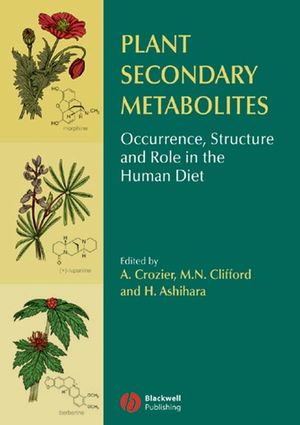Plant Secondary Metabolites: Occurrence, Structure and Role in the Human DietISBN: 978-1-4051-2509-3
Hardcover
384 pages
December 2006, Wiley-Blackwell
 This is a Print-on-Demand title. It will be printed specifically to fill your order. Please allow an additional 10-15 days delivery time. The book is not returnable.
|
||||||
1 Phenols, Polyphenols and Tannins: An Overview (Alan Crozier, Indu B. Jaganath and Michael N. Clifford).
1.1 Introduction.
1.2 Classification of phenolic compounds.
1.3 Biosynthesis.
1.4 Genetic engineering of the flavonoid biosynthetic pathway.
1.5 Databases.
2 Sulphur-Containing Compounds (Richard Mithen).
2.1 Introduction.
2.2 The glucosinolates-myrosinase system.
2.3 Chemical diversity of glucosinolates in dietary crucifers.
2.4 Biosynthesis.
2.5 Genetic factors affecting glucosinolate content.
2.6 Environmental factors affecting glucosinolate content.
2.7 Myrosinases and glucosinolate hydrolysis.
2.8 Hydrolytic products.
2.9 Metabolism and detoxification of isothiocyanates.
2.10 The Alliin-alliinase system.
2.11 Biological activity of sulphur-containing compounds.
2.12 Anti-nutritional effects in livestock and humans.
2.13 Beneficial effects of sulphur-containing compounds in the human diet.
3 Terpenes (Andrew J. Humphrey and Michael H. Beale).
3.1 Introduction.
3.2 The biosynthesis of IPP and DMAPP.
3.3 Enzymes of terpene biosynthesis.
3.4 Isoprenoid biosynthesis in the plastids.
3.5 Isoprenoid biosynthesis in the cytosol.
3.6 Terpenes in the environment and human health: future prospects.
4 Alkaloids (Katherine G. Zulak, David K. Liscombe, Hiroshi Ashihara and Peter J. Facchini).
4.1 Introduction.
4.2 Benzylisoquinoline alkaloids.
4.3 Tropane alkaloids.
4.4 Nicotine.
4.5 Terpenoid indole alkaloids.
4.6 Purine alkaloids.
4.7 Pyrrolizidine alkaloids.
4.8 Other alkaloids.
4.9 Metabolic engineering.
5 Acetylenes and Psoralens (Lars P. Christensen and Kirsten Brandt).
5.1 Introduction.
5.2 Acetylenes in common food plants.
5.3 Psoralens in common food plants.
5.4 Perspectives in relation to food safety.
6. Functions of the Human Intestinal Flora: The Use of Probiotics and Prebiotics (Kieran M. Tuohy and Glenn R. Gibson).
6.1 Introduction.
6.2 Composition of the gut microflora.
6.3 Successional development and the gut microflora in old age.
6.4 Modulation of the gut microflora through dietary means.
6.5 In vitro and in vivo measurement of microbial activities.
6.6 Molecular methodologies for assessing microflora changes.
6.7 Assessing the impact of dietary modulation of the gut microflora-does it improve health, what are the likelihoods for success and what are the biomarkers of efficacy?
6.8 Justification for the use of probiotics and prebiotics to modulate the gut flora composition.
7 Secondary Metabolites in Fruits, Vegetables, Beverages and Other Plant-Based Dietary Components (Alan Crozier, Takao Yokota, Indu B. Jaganath, Serena Marks, Michael Saltmarsh and Michael N. Clifford).
7.1 Introduction.
7.2 Dietary phytochemicals.
7.3 Vegetables.
7.4 Fruits.
7.5 Herbs and spices.
7.6 Cereals.
7.7 Nuts.
7.8 Algae.
7.9 Beverages.
7.10 Databases.
8 Absorption and Metabolism of Dietary Plant Secondary Metabolites (Jennifer L. Donovan, Claudine Manach, Richard M. Faulks and Paul A. Kroon).
8.1 Introduction.
8.2 Flavonoids.
8.3 Hydroxycinnamic acids.
8.4 Gallic acid and ellagic acid.
8.5 Dihydrochalcones.
8.6 Betalains.
8.7 Glucosinolates.
8.8 Carotenoids.
8.9 Conclusions.
Index.



